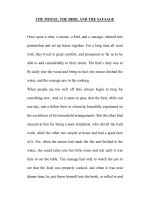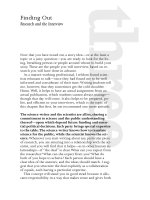Poe and the Printed Word - The novel
Bạn đang xem bản rút gọn của tài liệu. Xem và tải ngay bản đầy đủ của tài liệu tại đây (82.71 KB, 16 trang )
chapter 5
The novel
Readers in this country have a decided and strong preference
for works (especially ®ction) in which a single and connected
story occupies the whole volume, or number of volumes, as the
case may be.
± Harper and Brothers to Poe, June 1836
Discouraged from publishing his ``Tales of the Folio Club'' with
Philadelphia's largest publisher, Edgar Allan Poe turned to New
York's. The year before Poe came to Gotham, he corresponded with
one of its foremost literary ®gures as well as its leading publisher. Just
as he had sought John Pendleton Kennedy's assistance to place the
collection of tales with Carey, Lea, and Blanchard, Poe sought James
Kirke Paulding's help to place the book with the Harpers. Paulding
had established his literary reputation three decades before with
Salmagundi, an essay collection he wrote with Washington Irving, and
continued it through his satirical yet good-hearted Letters from the
South and such historical novels as Koningsmarke; or, Old Times in the
New World. Starting in 1834, the Harpers began issuing a collected
edition of Paulding's writings, a projected twelve- or ®fteen-volume
set. Poe did not know Paulding personally, but his employer, Thomas
W. White, had corresponded with him. Poe contacted him through
White and convinced him to take possession of his manuscript and
to bring it to the Harpers' attention. Paulding was aware of the
critical notices in the Southern Literary Messenger and admired Poe's
literary abilities; he did not mind doing a favor for the younger man.
Paulding had less in¯uence over the Harpers than White and Poe
had assumed, however, and he could not convince the ®rm to
undertake the ``Tales of the Folio Club.''
1
The Harpers declined the work for several reasons. Since the tales
had been published separately in the magazines already, they lacked
58
novelty. Also, Poe's stories were often too obscure to suit the general
reader, as the Harpers told Paulding and reiterated in a separate
letter to Poe. Furthermore, a longer, book-length narrative was more
suitable for publication than a collection of short stories. Though
Poe sought to give the volume-length work unity by creating a
narrative framework and bridging the separate tales with burlesque
criticism, it still could not pass muster as a single narrative. Repub-
lished magazine articles, the Harpers told Poe bluntly, ``are the most
unsaleable of all literary performances.''
2
In other words, the ®rm
rejected the ``Tales of the Folio Club'' using the same basic reason
Henry Carey had used to dissuade Poe from publishing the work
with his ®rm. After the Harpers' rejection, Poe continued to seek a
publisher for the work, yet he also took their advice to heart and
decided to write a book-length narrative.
Of course, the decision did not happen all at once, nor was it
made without reservation. Poe's editorial experience at the Southern
Literary Messenger had given him ample opportunity to develop his
critical precepts, and he felt much uncertainty toward the novel and
its various subgenres. The historical novel, which Sir Walter Scott
had raised to a new level of artistry, was immensely popular, but it
held little interest for Poe. Gothic novels had their heyday earlier in
the century, yet continued to be written, published, and sold. Speci®c
settings created other ®ctional subgenres. Sea novels, for example,
were becoming increasingly popular among both British and Ame-
rican readers. Another type of book-length ®ctional narrative, the
imaginary voyage, though categorized as a novel nowadays, was
infrequently seen as such in Poe's time. Nor was the term ``imaginary
voyage'' used. The reading public considered imaginary voyages
with real voyages and travels. For centuries, even the most truthful
travellers' tales were not without hyperbole, and the reader of non-
®ction voyages generally accepted brief forays into the fantastic with
a nod and a chuckle. When travel writers exceeded the limits of the
acceptable fantastic, readers took offense ± unless, of course, they
recognized the work as an intentional ®ction created for a didactic
purpose.
As imaginary voyages had developed since the days of Sir Thomas
More's Utopia three centuries before, they had changed little, for
they continued to satirize contemporary society and to provide a
utopian alternative to it. In other words, they perpetuated the long-
standing notion that literature must both delight and instruct. For
The novel 59
his short stories, Poe had repudiated the idea in favor of a forward-
thinking attitude toward literature as solely an aesthetic object,
something which delights yet need not instruct. Being a relatively
new literary genre, the short story had yet to receive much critical
scrutiny, so it escaped the standards by which book-length narratives
were judged. Books, because of their length as well as their publi-
cation as distinct works, were bound by stricter rules than short
stories. Most novels in Poe's day contained characters who exempli-
®ed proper moral conduct, and imaginary voyages often taught by
satirizing the faults and foibles of contemporary society. Poe, on the
other hand, foresaw a work with no particular instructive purpose.
Though the de
Â
nouement of the book-length narrative he would write is
seen today as an object lesson on the dangers of slavery, none of the
contemporary reviewers saw it as such, and it is unlikely Poe
intended it to be. Considering the disparity between his own
aesthetic notions and those by which contemporary books were
judged, Poe faced a dilemma: could he write a book-length narrative
without compromising his aesthetic principles?
Not only did the conservative standards by which novels were
judged violate Poe's aesthetic, but also the sheer length of a novel
made Poe question its ability to achieve a high level of artistry. Poe
believed that a literary work should be ®nely crafted and, following
Coleridge, he believed that every word counted. To that end, Poe
went one better than Coleridge: not only did every word count, the
placement of every word counted. Poe was a meticulous literary
craftsman, and he believed that a long story could never achieve
the tale's level of craftsmanship. (American literature would wait
until Henry James for a writer who brought such meticulous
craftsmanship to the novel.) The need to maintain suspense and to
keep a story going over hundreds of pages, Poe believed, required
the author to supply much additional exposition and incidental
detail which did not enhance the story's effectiveness or, to use
Poe's critical terminology, contribute to its totality of effect. Re-
viewing Robert M. Bird's Hawks of Hawk-Hollow, Poe thought the
author's ``subject appears always ready to ¯y away from him. He
dallies with it continually ± hovers incessantly round it, and about
it ± and not until driven to exertion by the necessity of bringing his
volumes to a close, does he ®nally grasp it with any appearance of
energy or good will.''
3
Short stories allowed authors tight control of
plot, action, and character, providing the opportunity to tell a
60 Poe and the printed word
highly compact tale, layering multiple levels of meaning one atop
another.
Given his objections to the novel, it is a wonder Poe decided to
write a book-length ®ctional narrative at all, but he was still
struggling for literary fame, and he well knew that contemporary
novelists were garnering more attention than other imaginative
writers. After deciding to write a book-length narrative, Poe also had
to decide what kind of book to write. When Paulding let him know
that the Harpers had rejected the ``Tales of the Folio Club,'' he
advised Poe to ``apply his ®ne humor, and his extensive acquire-
ments, to more familiar subjects of satire; to the faults and foibles of
our own people, their peculiarities of habits and manners.''
4
In other
words, he said, ``Write like me, and you will succeed.'' Though
Paulding gave Poe a formula for literary success, he did not tell him
that he could make a living with his pen. A proli®c writer himself,
Paulding was not a professional one. His books had achieved a fair
amount of popular acclaim, but by no means did he depend on
writing to survive. Rather, he had a completely separate career; he
held an upper-level administrative position with the US Navy. Poe
appreciated Paulding's writing yet realized that it was largely
derivative ± Addison and Steele as ®ltered through Sir Walter Scott.
Poe refused to change his writing style or mimic successful authors
simply for the sake of creating a marketable product.
The longest story he had written so far, ``Hans Phaall,'' gave Poe a
possible idea: he could write another imaginary voyage. Though
``Hans Phaall'' had been overshadowed by the success of Richard A.
Locke's ``Moon Hoax,'' by no means had the hoax genre been
exhausted. Rather, Locke's notoriety reinforced the popular poten-
tial for outrageous narratives feigning truth. Jealous of the other's
success, Poe analyzed the differences between his story and Locke's
and came to the conclusion that they differed most signi®cantly in
tone. Whereas he had written ``Hans Phaall'' in a ``tone of banter,''
Locke had written earnestly.
5
Though he would never have admitted
it, Poe learned from Locke. In his next imaginary voyage, he would
include some far-fetched detail, yet he would forsake banter and
assume a serious tone.
The literary hoax had a counterpart in the oral tradition, the tall
tale, a folk genre which may have in¯uenced Poe. Though Poe
largely avoided using folklore in more obvious ways such as making
familiar folk character-types into ®ctional characters, he appreciated
The novel 61
extravagant tales and legends. He may have had little contact with
adventurers who recounted their fantastic exploits, but personal
legends often appeared in the day's newspapers under the guise of
truth. In Poe's day, folk and print culture frequently overlapped; as
folk narratives made their way into print, printed works became part
of the oral tradition. The names of the most famous outrageous
travel writers, for example, became proverbs. Though copies of
Voyages and Adventures of Fernando Mendes Pinto, the sixteenth-
century Spanish travel liar, were hard to come by in nineteenth-
century America, his name had become a blason populaire used to
label any extravagant liar. Poe himself would use it in ``A Valentine,''
a cross-acrostic whose ``letters, although naturally lying / Like the
knight Pinto ± Mendez Ferdinando ± / Still form a synonym for
Truth.''
6
An even more popular label for tall-tale tellers was
``Munchausen,'' after Baron Munchausen, whose fantastic narrative,
Travels and Adventures, had been translated into English in the late
eighteenth century and had gone through countless editions. Since
``Hans Phaall'' incorporated many traditional motifs ± the murderer
escaping to the moon in a fantastic craft, for example ± and was
inspired partially by a tall tale, the traditional Irish story of Daniel
O'Rourke who visited the moon on the back of an eagle, Poe
conceivably looked to the oral tradition to help inspire his next
imaginary voyage.
As he mentally shaped the story, it became a far-fetched imaginary
voyage with a serious tone which used tall-tale rhetoric and
borrowed traditional motifs. Poe also needed to decide upon a
setting. Where could he take his hero? He could not send him to the
moon without being accused of plagiarizing Locke or repeating
himself, so the sky was off limits, but a land or ocean journey to an
unknown place remained possible. In the oral culture, frontiersmen
and sailors had the best reputation for tall tales. In the print culture,
genuine stories of Western travel proliferated, and narratives of
ocean voyages describing great deprivation and suffering had been
popular among American readers for decades. In colonial America,
Anson's Voyages had been the most popular story of ocean travel, and
it continued to be widely read in Poe's day. Its mixture of exotic
description and dire hardship let readers vicariously circumnavigate
the globe. The American West was becoming an increasingly
popular setting for romantic ®ction; the sea had long been so.
Frederick Marryat, the day's most popular sea novelist, greatly
62 Poe and the printed word
appealed to American readers. His tales of ocean adventure were
frequently reprinted, and Poe knew several of them. Though Poe
found Marryat's writing super®cial, he nevertheless felt his in¯uence.
After all, he was trying to do something he had never done before, to
write a book-length narrative for the popular market.
Among imaginary ocean voyages feigning truth, the most well-
known recent example was Sir Edward Seaward's Narrative of His
Shipwreck, and Consequent Discovery of Certain Islands in the Caribbean Sea:
with Details of His Residence There, and of Various Extraordinary and Highly
Interesting Events in His Life, from the Year 1733 to 1749,athree-volume
work written by Jane Porter yet told as a ®rst-person narrative from
her ®ctional protagonist's point of view. The Harpers had published
the work a half-dozen years before, and Poe probably read it in
Baltimore during the 1830s. He alluded to Seaward's Narrative in his
``Tales of the Folio Club,'' for he named one of the club members
``Mr. Solomon Seadrift'' and characterized him as a man ``who had
every appearance of a ®sh.'' Much later, Poe expressed his appreci-
ation of the work's verisimilitude.
7
Seaward's Narrative reminded Poe of Robinson Crusoe,aworkhehad
read in his boyhood and had returned to again recently. Just two
months before the Harpers rejected the ``Tales of the Folio Club''
Poe had the opportunity to reread Robinson Crusoe in a new edition.
The experience let him know that there were some books people
could read and enjoy in their adolescence and return to as adults
with a deeper, more abiding respect. His review of Robinson Crusoe
shows that the book started him thinking about the possibilities of
writing about an imaginary ocean voyage to a distant and unknown
land. Though he asserted that it was no longer possible to write a
similar story ± ``There is positively not a square inch of new ground
for any future Selkirk''
8
± one cannot help but see Poe behind these
words wondering if someone ± himself, perhaps ± could indeed write
a similar story, a story adolescents as well as adults could appreciate.
At this stage in his writing career, Robinson Crusoe represented for
Poe the ideal book-length ®ctional narrative. The work veri®ed that
it was possible for a book to achieve popularity among contemporary
readers and to continue to be read through the ages. After reviewing
the new edition, Poe continued to think about Defoe's book during
the next month. Reviewing Lambert Wilmer's The Confessions of
Emilia Harrington, Poe recalled Robinson Crusoe as well as other
important writers and works in literary history. In the best ®ction,
The novel 63









